
Features
Crop Culture
Inputs
Growing Points: What’s the problem?
August 7, 2012 By Dr. Mohyuddin Mirza
A basic knowledge of plant diseases is essential to properly diagnose problems and take corrective measures.
A basic knowledge of plant diseases is essential to properly diagnose problems and take corrective measures. If it can be done immediately, it is very helpful. If one has to wait for confirmation from a lab, it may be too late to save the crop.
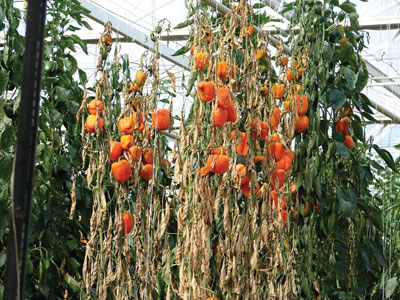 |
|
| Pythium can attack mature crops as well and cause significant economic losses. Sections of this pepper crop were affected by pythium due to irrigation issues. Advertisement
|
Many times growers diagnose the problem incorrectly and spray the wrong fungicides. Valuable time is lost in this process.
Sometimes growers jump to a conclusion very quickly and think that it may be a destructive disease and the entire crop may be lost. In this way, they spend countless nights worrying about their crops. I want you to look at the photos on this page.
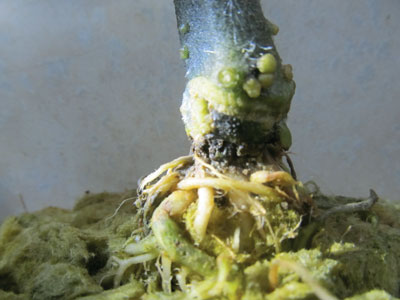
|
|
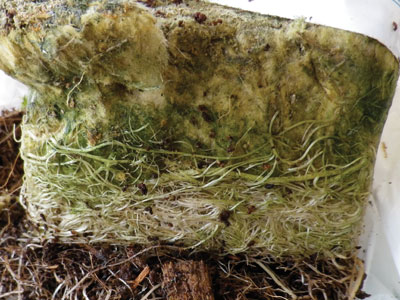 |
|
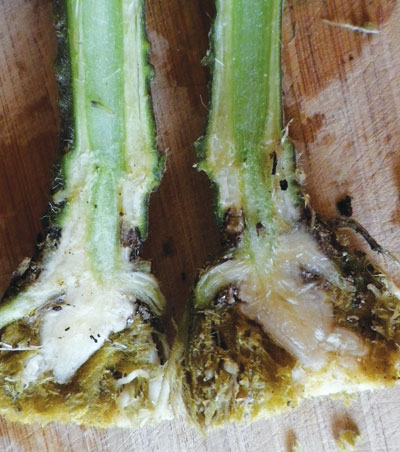 |
|
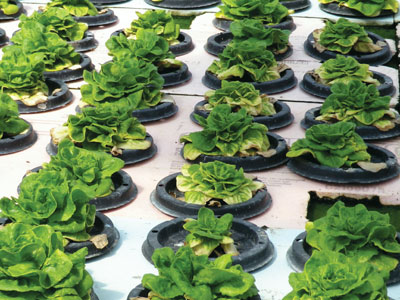 |
|
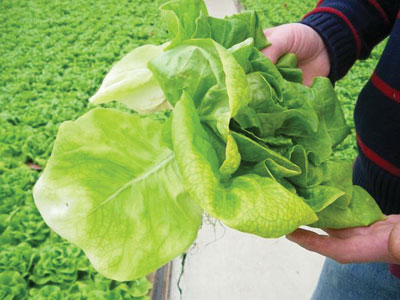 |
|
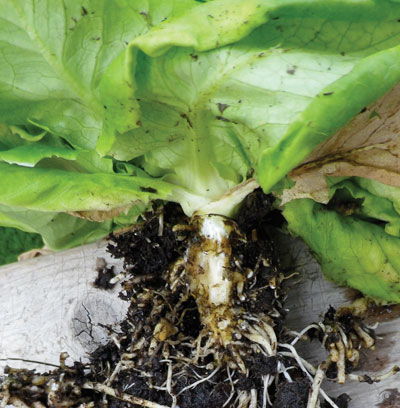 |
|
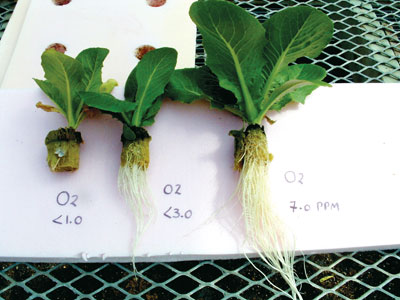 |
|
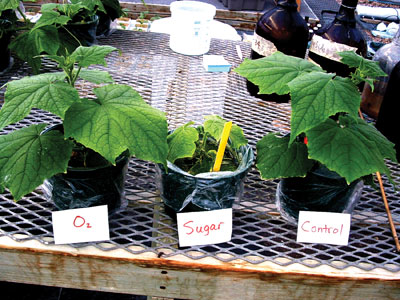 |
The grower had already thought that, as seen in the picture on left, it was a serious disease that could wipe out his mature tomato crop. He was concerned about the general appearance of the stem, the girdling and slight browning, and the thick roots emerging atop the rockwool block.
There was no wilting of plants reported by the grower.
When I removed the plastic around the rockwool cube, the roots were in good condition but there were no roots in the top half of the block.
I always cut open the stem to see if there is any browning of the water conducting tissue (xylem). Looking at the picture far right, I could not see any browning of xylem tissue, which appears as white stripes on the edges of the stem. That ruled out the possibility of fungi, such as verticillium and fusarium.
My diagnosis was that the stem issue was caused by salt burning, which was due to high electrical conductivity (EC). One can also see how the plant is trying to produce what are called “adventitious roots,” meaning that there is a stress on the stem.
I went a step further to cut off two inches of rockwool around the stem and separated it from the rest of the rockwool, soaked it in a small amount of water, and measured the EC. The EC around the stem was 6.8 millimhos and in the rest of the block was 4.2 millimhos, clearly displaying the fact that the stem has been “eaten into” by the high salt level; the plant is desperately trying to produce new roots to overcome this problem.
This simple determination of EC in the block provided the answer to stem girdling, and a visual examination of a vertical cross-section of the stem helped rule out the possibility of a fungal disease. This also meant the irrigation dripper was not located close to the stem, but instead at a distance – due to capillary action, fertilizer salts were moving upward. It was suggested to put some coir at the base of the stem after some leaching around the stem.
Now I want you to look at the above pictures of a floating lettuce system.
My first reaction: this was a serious nutritional problem, or possibly a virus, or a toxicity of some trace elements. The nutrient analysis confirmed very low levels of potassium, which was corrected.
On a subsequent visit to the greenhouse, it was found that there were root issues due to pythium fungus. In water-based systems, it can multiply quickly and thus spread to all crops. The picture on the right-hand side in the previous sequence shows some brown roots, indicating that pythium was involved.
WHAT DO WE KNOW ABOUT PYTHIUM?
■ I studied this fungus when I was doing work on my master’s degree, and that is 50 years ago. My teacher showed a slide of it under a microscope. I learned that it was a “water mould,” and that it produced motile structures to help it swim in water and attach itself to root tips.
Since that time, I have run into this fungus in cucumbers, tomatoes, peppers, lettuce, bedding plants and many other crops, and I’ve continued my research on it.
Other researchers have been doing work to better understand this fungus, but still it manages to return and attack crops.
The lettuce pictures included earlier in this feature offer a good example of a situation where an entire mature crop was attacked and rendered unsalable. This was especially devastating for the grower because it hit the crop at a time when there was a shortage in the market due to a recall of lettuce and a premium price was being offered. Here are some facts about pythium and understanding them will help to better manage your crops:
- Pythium is called a “root pruner,” meaning that it attacks root hair first and causes new growth of the plant to appear darker, wilting during high light conditions only to recover at night. The leaves are smaller in size. These symptoms reflect a restriction in water uptake.
- The development and growth of this fungus depends on “waterlogged” conditions. What is that condition when you are growing plants in a water-based system? It is the amount of oxygen in the growing medium.
The pictures on Page 19, highlight the importance of oxygen in nutrient solution. This was a study we did in 2003 at the Crop Diversification Centre North Edmonton.
The picture on left shows the effect of oxygen levels in nutrient solution. At levels of seven (7.0) ppm, the plants had good growth. However, at levels below 1.0 ppm, the roots did not come out of the rockwool cube and the roots had pythium on them.
The picture on right side is of cucumbers. The plant in the middle labelled “Sugar” is the one with oxygen levels below 2.0 ppm. Incidentally, we used sugar to encourage bacterial growth to deplete oxygen. This also means that if your water source has lots of microbial load then expect low oxygen levels in nutrient solution and waterlogged conditions may result easily.
Solubility of oxygen depends on water temperature and atmospheric pressure. For example, at 700 mm of atmospheric pressure the dissolved oxygen at 0ºC is 13.4 mg/L; at 20ºC it drops to 8.3; and at 25ºC it drops further to 7.6 mg/L (ppm).
In one study, I took measurements of oxygen at a greenhouse. Dugout water at 8ºC came at about 10 ppm of oxygen, it dropped to about 8 ppm in the holding tank when the temperature was 20ºC and then at drip line it dropped to 5 ppm. I think the irrigation lines had biological material inside and that used up the oxygen. I think growers should invest in a good oxygen meter and know what is going on through the irrigation system.
Pythium starts developing when the level of oxygen in a growing medium starts dropping below 4 ppm. Also remember there are pythium species that are more prevalent at cooler temperatures and also at warm temperatures.
For example, Pythium ultimum develops more in a temperature range of 4-15ºC, while Pythium aphanodermatum is more prevalent in 20-25ºC range.
STRATEGIES TO CONTROL PYTHIUM
■ In water-based systems, the best approach is to maintain dissolved oxygen at levels above 8 ppm. There are many oxygenation units available in the market.
If dugout water is used, make sure there are proper filters to remove finer dirt particles and have the water treated with disinfectants. Tests are available to determine levels of pythium in water. Cooling water down to lower temperatures in summer will help as well. Avoid high organic and microbial load in water.
In soilless growing media, the frequency of irrigation and volumes per irrigation need fine-tuning based on the type of growing medium. The growing media should not stay wet for a long period of time. You may have to depend on chemicals registered for use against pythium. Adjust irrigation on cloudy days.
If you recycle your nutrient solution, make sure your disinfection systems – such as UV light, heat pasteurization or ozone injectors – are working properly.
It’s also important to avoid stressing the plants. High EC under high light conditions causes roots to thicken and produce fewer new roots; thus, the plant cannot outgrow pythium.
Good success has been reported of the use of anti-pythium bio-agents. Many peat-based growing media now carry different types of bacteria and beneficial fungi to fight off pythium.
There are many strategies to control pythium-related root rot and growers must know the basics of this and other fungi to have good crops.
One point I have to emphasize is that it’s important to keep enough oxygen in your nutrient solution, and also to know the physical characteristics of your growing medium. The dynamics of oxygen in soilless media is different than in floating water systems. ■
Dr. Mohyuddin Mirza is a greenhouse consultant. • drmirzaconsultants.com
Print this page